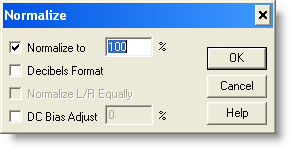

To apply RMS normalization, you must use the Group Waveform Normalize command. For example, if the original audio reaches a loud peak of 80% and a quiet low of 20%, normalizing to 100% amplifies the loud peak to 100% and the quiet low to 40%. Drag one or more audio files and drop them in the panel. Match loudness across multiple audio files Choose Window > Match Loudness to open the Match Loudness panel. The Normalize effect amplifies the entire file or selection equally. In Audition, you can measure loudness in audio clips and apply correction to support various loudness standards and true peak limiting. This will open the Noise Reduction dialogue box. When you normalize audio to 100%, you achieve the maximum amplitude that digital audio allows-0 dBFS. KEYBOARD SHORTCUT: CTRL+A (Windows), COMMAND+A (Mac) Go to the Effects menu and select Noise Reduction / Restoration then Noise Reduction (process). The Normalize effect lets you set a peak level for a file or selection. Using the Normalize effect (Edit View only) In the Effects tab of the Organizer window, expand Amplitude, and double-click Hardįor more information, search for “Hard Limiting options” in Help.

Select an audio range (Edit View) or track (Multitrack View). Go to Effects > Amplitude and Compression > Normalize, and select a percentage to normalize the clips volume to.

To prevent clipping, you can either use the Normalize effect to reduce the amplitude of the entire file (lowering perceived volume), or you can use the Hard Limiting effect to reduce amplitude only for loud passages (increasing perceived volume). For example, when you convert from 32-bit to 16-bit audio, particularly loud 32-bit passages can cause 16-bit clipping. This effect is particularly useful for increasing perceived volume because you can amplify audio beyond the digital maximum, 0 dbFS, and you can lower areas that would otherwise be clipped. The Hard Limiting effect drastically attenuates audio that rises above a defined threshold, leaving audio below the threshold unaffected.


 0 kommentar(er)
0 kommentar(er)
